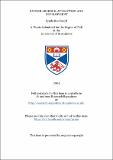Files in this item
Father absence, attraction and development
Item metadata
| dc.contributor.advisor | Perrett, David | |
| dc.contributor.author | Boothroyd, Lynda | |
| dc.coverage.spatial | 173 p. | en_US |
| dc.date.accessioned | 2018-06-18T12:52:13Z | |
| dc.date.available | 2018-06-18T12:52:13Z | |
| dc.date.issued | 2004 | |
| dc.identifier.uri | https://hdl.handle.net/10023/14199 | |
| dc.description.abstract | Since Draper & Harpending (1982) proposed that father absence would be associated with a shift in reproductive strategy, a body of literature has accumulated supporting their claims. This thesis explores further aspects of father absence theory, utilising computergraphic facial processing. It opens with an overview of both father absence theory (Chapter 1) and the Evolutionary Psychology of attraction (Chapter 2). Part 1 Part 1 explores the meaning of masculinity in partner choice scenarios. Male facial masculinity co-varied with facial age but not apparent facial health both in tenns of women's preferences (Study 1) and women's direct perceptions (Study 2). This suggested that masculinity in male faces is not a cue to immunocompetence health status as other authors have suggested, In Study 3, while masculine faces were perceived as more dominant than feminised faces, they were otherwise considered poorer quality partners. It was suggested that masculinity was attractive because of a 'sexy son' mechanism (dominance increasing offspring reproductive success), which was traded off against the anti-social traits associated with masculinity. Part 2 Studies 4, 5 and 6 found that father absence or poor relationships with the parents generally reduced masculinity preference and age preference (although in Study 5, this effect was moderated by relationship status). This contradicted predictions made from traditional father absence literature (that father absence should be associated with a short term strategy and therefore masculinity preference). Sociological explanations were discounted as family background did not relate to the traits women said they desired in a partner (Study 7). Altogether these results raised questions about the attractiveness and self-esteem of father absent females. Part 3 therefore investigated the physical development of these females. Part 3 Study 8 found that marital difficulties between parents were associated with an increase in perceived facial masculinity in both male and female offspring's faces, a decrease in facial attractiveness and increased weight and waist-hip ratio in women. Study 9 found that levels of progesterone were inversely related to quality of parental relationship. The overarching conclusions of the thesis were that there appears to be an effect' of physical masculinisation which is associated with father absence. This masculinisation may be the predicator for previously observed father absence effects, and the results in Part 2. As such, attachment based explanations of father absence effects (such as Belsky et al, 1991) may be redundant. | en_US |
| dc.language.iso | en | en_US |
| dc.publisher | University of St Andrews | |
| dc.subject.lcc | HM1151.5B7 | |
| dc.subject.lcsh | Interpersonal attraction | en |
| dc.subject.lcsh | Paternal deprivation | en |
| dc.subject.lcsh | Sex (Psychology) | en |
| dc.subject.lcsh | Evolutionary psychology | en |
| dc.subject.lcsh | Masculinity | en |
| dc.subject.lcsh | Femininity | en |
| dc.title | Father absence, attraction and development | en_US |
| dc.type | Thesis | en_US |
| dc.type.qualificationlevel | Doctoral | en_US |
| dc.type.qualificationname | PhD Doctor of Philosophy | en_US |
| dc.publisher.institution | The University of St Andrews | en_US |
This item appears in the following Collection(s)
Items in the St Andrews Research Repository are protected by copyright, with all rights reserved, unless otherwise indicated.

